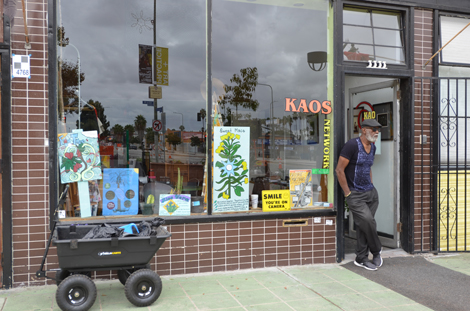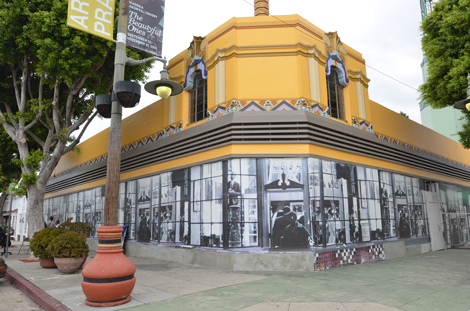Step off the Metro line at Crenshaw and Martin Luther King in 2019, and the first thing you’ll be greeted by is the Baldwin Hills Crenshaw Plaza, a gray monolith of Macy’s, Sears and Wal-Mart. But look further south down Crenshaw, and you’ll notice an afro rising like a mushroom cloud above the Krispy Kreme bags and Jack-in-the-Box cups.
“I needed to transform the energy,” the muralist’s author, Patrick Henry Johnson, says of the silhouette of his ex-girlfriend on the Liquor Bank wall—“To break the bonds I had with her and pour my love into painting.” The original mural took two months in 2011. On the last Sunday in August, Johnson is in the third week of reviving it: a 40-foot silhouette of an African woman with the Milky Way floating in her head, the moon in her throat, the planet—Africa the only continent visible—above her heart. He barely gets three brushstrokes done before a woman, smile big as God’s, interrupts and offers her translation: “I think it’s saying the black woman’s brain is the universe and she speaks the world, baby!”
“No one messes it up or graffitis it,” Johnson says between dabs of paint. “Everyone in Leimert has this sense of ‘That’s ours.’”
A few blocks away, jackhammers take a day off from Metro rail-stop work at Leimert Park Village. The MTA initially balked at the idea of extending the line, arguing the mall stop was sufficient and commuters could easily walk to Leimert. But activists launched a two-year fight to extend the line to “the village” and its Afrocentric shops, galleries and, on the last Sunday of every month, Artwalk. Leading the charge for this cultural hub is transmedia artist Ben Caldwell.
“Leimert Park is the backbone of LA,” Caldwell says. “We’re the vertebrae. Every person that’s going to Beverly Hills or Santa Monica or Burbank will have to pass through here. What can we do to make them stop?”
Caldwell and I sit at a wooden counter—potted plants in its center alcoves—that the artist built and set outside his for-profit community gallery, the KAOS Network. Tonight is both the Artwalk and Caldwell’s birthday (he’s turning 70), and I rarely get a sentence out before one of the hundreds of festival-goers—wearing D&G to Dashiki—interrupts to sing him a song, get his photo, or ask him to intervene and stop a fight.
While at UCLA in the 1970s, Caldwell teamed up with fellow African-American artists to form what would be christened the “LA Rebellion”—black Angeleno artists creating films in response to the Blaxploitation movies of Hollywood. In the intervening 40 years, Caldwell has brought a similar ethos to photography, instillations, ethnography, education and entrepreneurship; in Leimert, he’s performed an artistic fusing of all of these.
Often, gentrification begins with artists moving into a decaying area which thus becomes hip, and then becomes attractive to nonartists (see: the Downtown Arts District). “When people talk about gentrification,” the white-whiskered Caldwell says, “what they mean is white people coming back in.” Caldwell, perhaps because he’s an artist, sees things differently: “The Artwalk grew out of a need to define ourselves and stem off gentrification.” If he could bring people in, he could gentrify from the inside instead of out. “We used what’s called the Phantom Gallery concept”—going into desolate areas and putting art in the storefronts. Caldwell met with the owners of the abandoned buildings and pitched the idea. “I asked them to hook me up with keys and once a month I’d put in art that would help sell the buildings and beautify the neighborhood when the Artwalk launched.”
I suggest it’s like a reverse Broken Windows theory—instead of shattered glass signaling “This is a place where crime is acceptable,” Caldwell’s efforts signaled that Leimert could be a place of beauty. “Artists are supposedly good at that,” he laughs. “The twist is we artists own it. Artists ended up buying all the places.” Gentrification driven by, but also benefiting, black artists.
“I own these three buildings,” he points to KAOS and the theater space beside it, then continues pointing to the spaces lining Leimert Plaza Park. “Marc Bradford owns those, Eileen Norton those …” Caldwell rattles off a list of names before circling back to the Metro line. “You can’t name an internationally famous African American who didn’t live or work in this area—John Coltrane, Richard Pryor, Ella Fitzgerald. The world stops when they hear or see our work. If we can let them know that Leimert Park is ground central for the black arts movement, I think that’s how we get people stopping at our Metro line.” Guided-tour apps, a SXSW with “Leimert flavor,” a food court with local dishes, destination galleries, and the ArtWalk are all part of Caldwell’s vision to get people to jump off the train.
Why, I ask Caldwell to explain, does LA need a Leimert? Little Tokyo, Koreatown, Little Ethiopia—these make sense as they’re pockets of those cultures. But African Americans are spread throughout the city. What is Leimert? Little African-American LA?
“Every other community here has ties to their homeland,” Caldwell explains. “Mexican immigrants send money back to the towns they left, but African Americans are a culture of diaspora. We’re like… ” he looks up and around, nodding to those who’ve been waiting for eye contact to greet him, and picks up a poinsettia from the counter’s alcove. “Africans have been treated like potted plants. You take them, move them wherever you want, cut off the fruit you need, and then you leave them there or move them somewhere else.” He places the potted plant back in the counter’s center. “This Metro stop connects Leimert to LAX. So it connects us to the rest of world.” Caldwell spreads his hands like roots across an invisible map of LA and beyond. “That’s why I dreamed of having a Metro stop here.”
As I stroll by the mural when leaving Leimert, Johnson is adding paint to the title. “The first pass was good,” he yells to my car, “but there’s always more to do.” He then dabs black paint on the words “Elixir: The Rebirth.”





